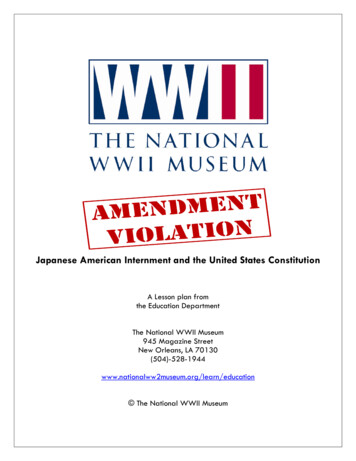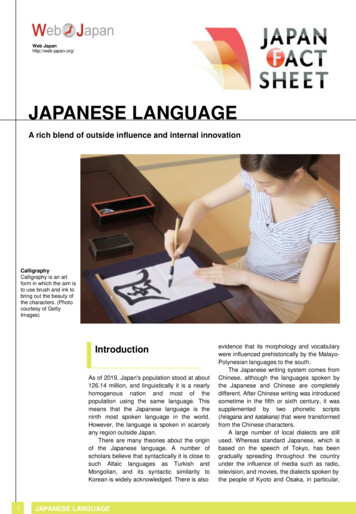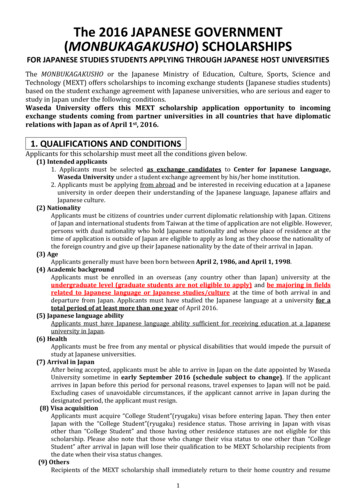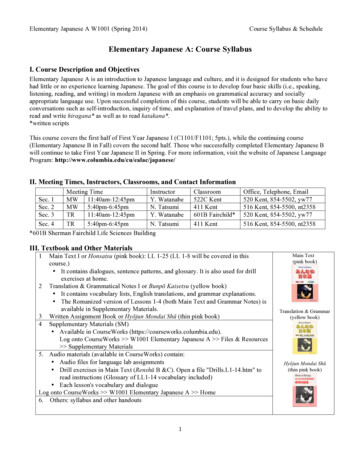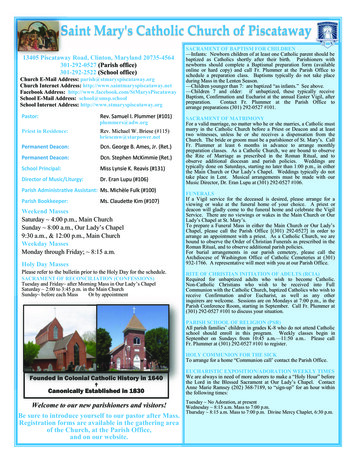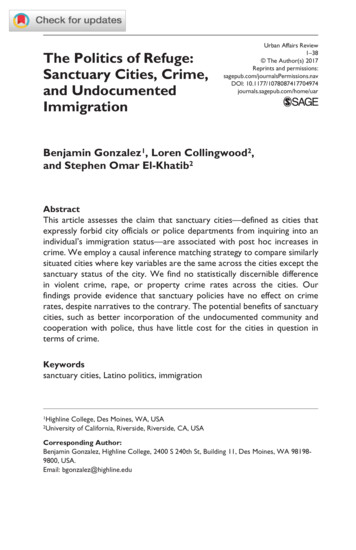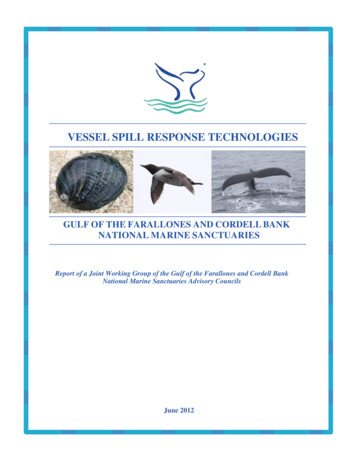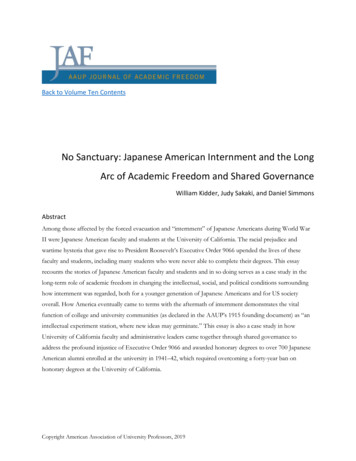
Transcription
Back to Volume Ten ContentsNo Sanctuary: Japanese American Internment and the LongArc of Academic Freedom and Shared GovernanceWilliam Kidder, Judy Sakaki, and Daniel SimmonsAbstractAmong those affected by the forced evacuation and “internment” of Japanese Americans during World WarII were Japanese American faculty and students at the University of California. The racial prejudice andwartime hysteria that gave rise to President Roosevelt’s Executive Order 9066 upended the lives of thesefaculty and students, including many students who were never able to complete their degrees. This essayrecounts the stories of Japanese American faculty and students and in so doing serves as a case study in thelong-term role of academic freedom in changing the intellectual, social, and political conditions surroundinghow internment was regarded, both for a younger generation of Japanese Americans and for US societyoverall. How America eventually came to terms with the aftermath of internment demonstrates the vitalfunction of college and university communities (as declared in the AAUP’s 1915 founding document) as “anintellectual experiment station, where new ideas may germinate.” This essay is also a case study in howUniversity of California faculty and administrative leaders came together through shared governance toaddress the profound injustice of Executive Order 9066 and awarded honorary degrees to over 700 JapaneseAmerican alumni enrolled at the university in 1941–42, which required overcoming a forty-year ban onhonorary degrees at the University of California.Copyright American Association of University Professors, 2019
AAUP Journal of Academic FreedomVolume Ten2The military police opened the bus door and we stepped into the bus as our family number was called . . .We were silent on the trip except for a group of four University of California boys who were singing collegesongs. The bus crossed the Bay Bridge. Everyone stared at the beautiful view as if for the last time. Thesinging stopped.—Miné Okubo, in her memoir Citizen 136601“Alien Order Hits U.C. Staff: 30 Faculty MembersFace Evacuation”—San Francisco News headline, March 5, 19422“22 Japanese Are Employed at University”—Seattle Times headline, February 27, 19423Trucks take away the last Japanese Americanchildren and adult residents of Redondo Beach,California, April 1942.Thousands are housed in stables which retain smells of the animals. A stable which housed a horse nowhouses from 5 to 6 humans, its ventilation is poor due to the absence of windows. A stable is generallypartitioned into 2 parts, the back-part is dark. These are not only unsanitary, but mentally and morallydepressive.—Stanford professor Yamato Ichihashi, diary entry May 28, 1942, Santa Anita4The Court for all time has validated the principle of racial discrimination in criminal procedure and oftransplanting American citizens. The principle then lies about like a loaded weapon ready for the hand of anyauthority that can bring forward a plausible claim of an urgent need. Every repetition imbeds that principlemore deeply in our law and thinking and expands it to new purposes.—Justice Robert Jackson, dissenting in Korematsu v. United States (1944)5There are times in the history of the United States of America when, driven by fear, racism, or masshysteria, the government of our country with the support of the represented people has taken actions thatdeny to some peoples the “unalienable rights of life liberty and the pursuit of happiness” upon which ournation was founded.6 President Roosevelt’s Executive Order 9066 in February 1942 requiring the forced
3No SanctuaryWilliam Kidder, Judy Sakaki, and Daniel Simmonsremoval and incarceration in remote camps of nearly 120,000 Americans of Japanese descent was one suchblack mark on our history. The extreme and wrongful denial of civil rights, which was widely supported at thetime, was later recognized by the Congress and the president as a grave injustice.7 While no amount ofreparations can restore the lost years and pain of the forced removal, the University of California took a smallstep in this direction by awarding honorary degrees to former students who were spirited away toconcentration camps during the hysteria of 1942 and thus were unable to complete their UC education. Thisessay recounts some of the history of interned UC students and faculty—a history that reveals the enduringimportance of academic freedom and shared governance in the life of a university community—in the hopethat a deeper recognition of the tragic events associated with Executive Order 9066 will help prevent othersuch deprivations of civil rights and civil liberties.8The forced removal and incarceration (euphemistically called “internment”) of people of JapaneseAmerican ancestry residing on the West Coast, the vast majority of them US citizens, affected severalthousand students, faculty, and staff at the University of California and other universities and colleges inCalifornia, Oregon, and Washington State. A substantial scholarly literature has addressed the gravedeprivation of Japanese American citizens’ civil liberties by the federal government during World War II. Forpresent purposes, it is important for us to define at the outset about how academic freedom is different innature from civil liberties, given that this essay goes back and forth between themes of civil liberties andacademic freedom over a span of several decades.In his essay on the rise of academic freedom in American higher education, historian Thomas Haskellcautions that “academic freedom and free speech overlap and reinforce one another only at certain points. . . .Historically speaking, the heart and soul of academic freedom lie not in free speech but in professionalautonomy and collegial self-governance.”9 Similarly, Matthew Finkin and Robert Post define the essence ofacademic freedom (as a professional value and norm within the academy, distinct from academic freedom’sFirst Amendment constitutional dimensions) as the fact that universities and colleges “serve the commongood by producing knowledge and . . . the production of knowledge requires freedom of inquiry.”10 Thedistinction is critical, all the more so given the strong pull of America’s “culture of rights” and correspondingtendency to blur distinctions about the historical origins and structure of academic freedom versus civilrights/liberties.11Moreover, the interplay of academic freedom and internment is far less appreciated as a topic of scholarlyexamination. Japanese American internment, in fact, marked a profound intrusion by the government into thecore academic mission of many West Coast universities and colleges. This essay is a reminder that threats toacademic freedom can arise from numerous sources, both within and outside the academy.12
AAUP Journal of Academic FreedomVolume Ten4Academic freedom provides an important perspective when coming to terms with the tidal wave of raceprejudice, war hysteria, and failed political leaderships that engulfed America in the months following theattack on Pearl Harbor. The AAUP’s seminal 1915 Declaration of Principles on Academic Freedom and AcademicTenure warned of the dangers in a democracy associated with “overwhelming and concentrated publicopinion,” and it advanced the notion that the university “should be an intellectual experiment station, wherenew ideas may germinate and where their fruit, though still distasteful to the community as a whole, may beallowed to ripen until finally, perchance, it may become a part of the accepted intellectual food of the nationor of the world.”13 As we will show, the problem of concentrated public opinion and the enduring value ofthe university as an intellectual experiment station are made vividly clear by the historical context surroundingExecutive Order 9066 and related events.Images of the evacuation in California, 1942: left, Tatsuro Masuda declares “I am an American,” but must sell hisOakland grocery store; center, military signs ordering evacuation, San Francisco; right, arrivals to the assemblycenter at the Santa Anita racetrack.The Impact on FacultyThe ink was barely dry on the 1940 Statement of Principles on Academic Freedom and Tenure declaring that academicfreedom in teaching is “fundamental for the protection of the rights of the teacher in teaching and of thestudent to freedom in learning”14 when West Coast newspapers ran matter-of-fact articles about the Japaneseand Japanese American college faculty who were about to be incarcerated. At the height of racial hysteriaduring World War II, scores of faculty members15 at West Coast colleges and universities were among the120,000 Japanese Americans incarcerated (that is, “evacuated”) and sent first to assembly centers and then topermanent camps for most or all of the war years.16 Their lives were uprooted (being forced not only to leavetheir jobs but also to abandon their homes, farms, and businesses) as, without charge or hearing, they were
5No SanctuaryWilliam Kidder, Judy Sakaki, and Daniel Simmonsincarcerated, in concentration camp facilities with barbed wire fences and armed guards, in desolate parts ofthe country.17Sober self-reflection and scholarly critique about the academy’s past failings with respect to the defenseof academic freedom and civil liberties is an important attribute of academic freedom.18 In the World War IIera even the AAUP’s Committee A on Academic Freedom and Tenure dismissed concerns about thedeprivations of Japanese Americans’ civil liberties brought about by evacuation and internment. Committee Acontinued to articulate this view at the close of the war, when the grip of racial hysteria began to abate.19Articles in the AAUP Bulletin—otherwise a beacon of academic freedom—at times demonstratedindifference to how internment curtailed the academic freedom of Japanese American faculty.20 CommitteeA’s 1945 report in the AAUP Bulletin noted that governmental action during the war “has not been uniformlycommendable” but nonetheless concluded that “the more enlightened treatment of conscientious objectorsand the comparative absence of trials and imprisonment for ill-defined subversive offenses probablyoutweigh the removal of the Japanese from the West Coast and their confinement to concentration camps.”21This chapter of AAUP history has attracted far less scholarly attention than the AAUP’s similarly insufficientresponses to threats to academic freedom during the height of McCarthyism.22Wartime racial prejudice was fueled by a climate of bullying and intimidation. For example, days afterPearl Harbor, a vigilante fired gunshots through the window of UC Berkeley professor Chiura Obata’s familyart studio blocks from the UC Berkeley campus.23 A few months later Obata was sent to the TanforanAssembly Center, where the living quarters were refashioned horse stalls. He was later sent to the Topazinternment camp in Utah.Though Obata probably never had a chance to read the 1940 Statement of Principles of Academic Freedombefore being incarcerated, he nonetheless embodied what the 1940 Statement describes as the “dutiescorrelative with” rights of academic freedom. On the eve of being evacuated he had already started to planfor an art school that ended up involving 600 Japanese American students at Tanforan and Topaz. In 1942Obata had a simple, fundamental explanation for why he viewed the art school as particularly important inthe face of the deprivations thrust upon his community: “In any circumstance education is as important asfood to a human individual whether young or old.”24 After his release from Topaz, Obata found work withan art company in St. Louis and returned to teaching at Berkeley in 1945 until retiring as professor emeritus in1954.25
AAUP Journal of Academic FreedomVolume Ten6Left and center, University of California and California State Colleges students at Sacramento Assembly Center,1942; right, one hundred orphans sent to the “Children’s Village” at Manzanar, 1942.Academic Freedom during and after One of America’s Darkest HoursFour decades after Obata and other Japanese Americans on the West Coast had their lives uprooted, thecongressionally created Commission on Wartime Relocation and Internment of Civilians (CWRIC) conducteda lengthy investigation of circumstances surrounding Executive Order 9066. The commission’s book-lengthreport, Personal Justice Denied, found that Executive Order 9066 “was not justified by military necessity” andthat the “broad historical causes that shaped these decisions were race prejudice, war hysteria and a failure ofpolitical leadership.”26Reflecting the predominant views of the day, California governor Culbert Olson told a room of JapaneseAmerican news editors in early 1942, “You know, when I look out at a group of Americans of German orItalian descent, I can tell whether they are loyal or not. I can tell how they think—but it is impossible for meto do this with the inscrutable orientals, and particularly the Japanese. Therefore, I want all of you presenthere to pledge yourselves to make a sacrifice for your country, the U.S. of A. Promise to give up yourfreedom, if necessary, in order to prove your loyalty.”27 Similarly, California Congressman Ward Johnsonbluntly advised the Roosevelt administration in February 1942, “Let’s move these Japanese out and talk aboutit afterwards.”28When the congressional Tolan Committee held hearings in West Coast cities on the topic of “NationalDefense Migration” in February and March 1942, only faculty members, clergy, social workers, and variouscivil liberty and community group members stated their opposition on the record.29 The governors ofCalifornia, Washington, and Oregon as well as two state attorneys general and numerous city and countyofficials all testified in favor of “evacuation,” as did urban and rural business interests.30 No California publicofficials testified in opposition to the mass incarceration of Japanese Americans. The mainstream press at thetime was virtually unanimous in supporting the removal of Japanese Americans (including the New York
7No SanctuaryWilliam Kidder, Judy Sakaki, and Daniel SimmonsTimes, San Francisco Chronicle, and Los Angeles Times), and several publishers like McClatchy (Sacramento Bee andFresno Bee) and Hearst (San Francisco Examiner) had long been aligned with anti-Japanese civic organizations.31The Los Angeles Times editorialized as follows: “A viper is nonetheless a viper wherever the egg is hatched—soa Japanese American, born of Japanese parents—grows up to be a Japanese, not an American.”32The Pacific Coast Committee on American Principles and Fair Play was one of the few outspokenorganizations opposing evacuation and internment during World War II; its board members included UCpresident Robert Gordon Sproul and several other college presidents.33 Reflective of the bullying atmosphereof the day, the Fair Play Committee itself became the subject of an investigation by the California legislature.A December 1943 hearing was led by Assemblyman Chester Gannon, who lined up witnesses sharing “horrortales” about Japanese Americans, each more outlandish than the next; lawmakers expressed disappointmentwhen one of the testifying officials admitted “I’ve tried to, but can’t find any” evidence of wrongdoing byJapanese Americans.34 Time magazine described the Gannon hearing as the “Inquisition in Los Angeles” andeven the (pro-internment) Los Angeles Times criticized the lawmakers for becoming “witch-burningagencies.”35Illustrative of academic freedom’s value during this dark period, one of the most outspoken critics againstinternment was UC Berkeley political scientist Eric Bellquist, who had recently been elevated from instructorto professor.36 The CWRIC’s report, Personal Justice Denied, recounts the following: “Eric C. Bellquist, aprofessor of political science at Berkeley, presented to the Tolan Committee a lengthy and remarkably wellinformed analysis which forcefully dissented from the policy of exclusion and evacuation. A few days later,Monroe Deutsch, Provost of the University of California, sent a telegram to Justice Felix Frankfurterprotesting evacuation of people, including the Japanese, identified only as members of a group. To Deutschthis struck ‘an unprecedented blow at all our American principles.’”37The few dissenting voices, however important, were hardly enough to stem the rising tide of racialprejudice. In late March 1942, Congress passed Public Law 503, which made it a crime to disobey the militaryorders made pursuant to Executive Order 9066. Three days later Lt. Gen. John DeWitt, head of the WesternDefense Command, began issuing a series of 108 Civilian Exclusion Orders in rapid succession.38 Massincarceration would follow in the days and weeks to come, forever changing the lives of Japanese Americanfaculty and students.
AAUP Journal of Academic FreedomVolume Ten8Left, armed watch tower at Santa Anita (Arcadia), 1942; center, art school at Tanforan, 1942; right, library atManzanar, 1942.The Impact on StudentsIn 1941–42 over 700 Japanese American students were enrolled at the University of California (Berkeley,Davis, Los Angeles, and San Francisco) and 250 were enrolled in the California State Colleges; all told therewere approximately 3,200 Japanese American students spread across California, Oregon, and Washingtoncolleges and universities. 39 One of those students was Professor Chiura Obata’s son, Gyo Obata, then afreshman at UC Berkeley. As the family’s scheduled evacuation reporting date in April was fast approaching,Gyo Obata told his father that he did not believe he could bring himself to submit to the evacuation orders,and he asked for his father to help him resettle and hopefully reenroll in college (this was after the shortperiod in the spring of 1942 when “voluntary resettlement” was allowed), even though it would mean beingseparated from the family at a time of great peril and uncertainty. Through the aid of a sympathetic formerstudent of Chiura Obata’s who worked as a military official, Gyo was able to relocate to St. Louis and study atWashington University.Most of the Japanese American students at UC were sent to assembly centers and internment camps,and, while many eventually transferred to colleges and universities in the Midwest and on the East Coast,most were never able to return to their studies at UC and some were never able to return to higher educationat all because of pressing family needs and financial hardships wrought by the traumatic aftermath ofinternment. In addition, some Japanese American students forced to withdraw from UC because ofExecutive Order 9066 went directly from internment camps to military service and died in combat. GyoObata served in the Army, and later became a preeminent architect; his work ranges from the AbrahamLincoln Presidential Library to the Japanese American National Museum.40 Further below, we describe howin 2009, sixty-seven years after he was forced to leave UC Berkeley, Gyo Obata was granted an honorarydegree by the University of California.
9No SanctuaryWilliam Kidder, Judy Sakaki, and Daniel SimmonsLeft, Chiura Obata painting of Topaz, 1943; right, Korematsu legal appeal team led by UC faculty and alumni, 1983.Academic Freedom in Correcting an Epic InjusticeAs constitutional and academic freedom scholar Peter Byrne argues, a core attribute of university researchand teaching is “academic speech,” which he distinguishes from the basic First Amendment protection ofspeech. “Academic speech,” Byrne writes, “rests on its commitment to truth . . . its honesty and carefulness,its richness of meaning, its doctrinal freedom, and its invitation to criticism.” Byrne argues that because ofthese stringent standards and commitment to truth, academic speech “contributes profoundly to society atlarge” and creates an “experience of academic freedom [that] helps secure broader, positive liberties ofexpression.”41 Academic inquiry involves an unrelenting ethos of rigorous examination that yields benefitsaccruing over time as contemporary scholarship sheds new light on (and in some cases repudiates) priorscholarship, popular beliefs, and official history.And so it was with the gradual reexamination of Japanese American internment. While several books andarticles critical of internment were published shortly after the war,42 a broader reckoning with the meaning ofthis episode in American history did not occur then. For example, Citizen 13660 (1946) by Miné Okubo, a UCBerkeley graduate (BA, 1935; MFA, 1936) and an artist who taught during her incarceration alongside ChiuraObata, was the first book by a Japanese American on the topic of wartime evacuation and internment,recounting her experiences at Tanforan and Topaz.43 Her memoir only received wider attention, however,during the 1980s in connection with the Commission on Wartime Relocation and Internment of Civilians.
AAUP Journal of Academic FreedomVolume Ten10The experience of incarceration and dislocation during World War II represented collective andintergenerational experiences of profound trauma for the Nisei, Sansei, and subsequent generations ofJapanese Americans.44 Even in 1967, when professors Harry Kitano of UCLA and Roger Daniels (then atUCLA and later at the University of Cincinnati) organized the first academic conference on the twenty-fifthanniversary of Executive Order 9066, community groups were reluctant to support the conference (and evenpressured Kitano to stop it), and so the conference could only find sponsorship from the UCLA Extensionoffice.45 “Only years later did I learn that extreme pressure was placed on Harry to abandon the project,”Daniels recalled. “Among the tactics employed by community leaders was persuading some senior membersof his family . . . to call him up and tell him that what he was doing would be bad for the community andwould even disgrace the family name.”46 For most of the Japanese American community the experience ofinternment still remained too painful and overwhelming to discuss either within the family or in broadercontexts.Beginning in the late-1960s, the fruit of new ideas slowly began to ripen until they were—in the languageof the AAUP’s 1915 Declaration—no longer “distasteful to the community as a whole.” Led by a youngergeneration of Japanese American activists, many in the community came to view the aftermath of internmentas a critical issue that needed to be confronted in light of their experiences connecting with the civil rights andantiwar movements. Scholars like Kitano and Daniels provided intellectual nourishment for this nascentmovement with influential works that questioned the official history of internment found in War RelocationAuthority documents.47Academic freedom also played an underappreciated role in the civil rights odyssey of Fred Korematsu, ayoung welder who was picked up by police in San Leandro, California, in May 1942 and convicted for notreporting for evacuation.48 Korematsu and his legal team challenged the constitutionality of the exclusionorder on grounds of military necessity, with the US Supreme Court upholding Korematsu’s conviction in1944, in a 6–3 decision that stands out today as among the Court’s more discredited rulings, one that theCWRIC years later described as “overruled in the court of history.”49 In a scathing dissent in Korematsu(quoted in one of the epigraphs to this essay), Justice Robert Jackson warned that the majority’s decisionwould enable future racial discrimination. After the war, Korematsu got on with his life, though his criminalconviction limited his earning potential, and for nearly forty years Korematsu rarely spoke of his legal case orhis wartime incarceration.Korematsu’s world changed in 1982 when he reluctantly agreed to be interviewed by UC San Diegopolitical science professor and legal historian Peter Irons, who was working on a book about the JapaneseAmerican civil rights cases decided by the Supreme Court during World War II. In the course of his research,
11No SanctuaryWilliam Kidder, Judy Sakaki, and Daniel SimmonsIrons filed Freedom of Information Act requests for Justice Department and War Department records. Withassistance from a sympathetic archivist Aiko Herzig-Yoshinaga, who was working for the CWRIC, Ironsuncovered a number of “bombshell” documents out of the millions and millions of pages of internmentrelated materials (heretofore poorly archived) in the National Archives.50One of the most significant documents uncovered was the only remaining copy of the original 1943 finalreport to the War Department by Lieutenant General DeWitt on West Coast evacuation. When the JusticeDepartment was defending evacuation before the Supreme Court, it based its “military necessity” defense onthe lack of time to conduct individual loyalty hearings, whereas DeWitt’s original report stated, “Because ofthe ties of race, the intense feeling of filial piety and the strong bonds of common tradition, culture andcustoms, this population presented a tightly-knit racial group. . . . It was impossible to establish the identity ofthe loyal and the disloyal with any degree of safety. It was not that there was insufficient time in which tomake such a determination; it was simply a matter of facing the realities that a positive determination couldnot be made, that an exact separation of the ‘sheep from the goats’ was unfeasible.”51Such conclusions were colored by DeWitt’s well-documented racist views about Japanese Americans.52The DeWitt report also contained intelligence claims about alleged espionage and disloyalty that the JusticeDepartment knew to be false. When Justice Department lawyers attempted to disavow the DeWitt report in afootnote in the government’s brief to the Supreme Court, the War Department and the US solicitor generalintervened to stop the printing of the brief and have it revised to the War Department’s satisfaction.53 SeniorWar Department officials recognized the final DeWitt report as a major liability in defending theconstitutionality of the military orders, so the War Department pressured DeWitt to alter and reissue a new“final” report, with orders to burn the earlier galley proofs, drafts, and associated memoranda.54Professor Irons presented a draft of his book Justice Denied as part of the CWRIC’s evidentiary record, anda judge on the CWRIC asked Irons if the unearthing of so much new evidence posed an opportunity for thewartime Japanese American cases to be reopened through a writ of coram nobis.55 Irons vigorously pursued thissuggestion, collaborating with team of attorneys affiliated with the Asian Law Caucus—including over adozen alumni of the University of California (most of them Sansei).56 Led by Irons and counsel of recordDale Minami, the group sought to reopen Korematsu’s case in US District Court in San Francisco in 1983alongside parallel efforts by Sansei attorneys to reopen the World War II–era cases of Gordon Hirabayashi inSeattle and Minoru Yasui in Portland, Oregon.In 1984, the District Court in San Francisco granted Korematsu’s petition for a writ of coram nobis, notingthat such writs are reserved for correcting “errors that result in a complete miscarriage of justice.”57 In herruling from the bench, Judge Marilyn Hall Patel stated that the government’s military necessity justification
AAUP Journal of Academic FreedomVolume Ten12was “based upon . . . unsubstantiated facts, distortions and representations of at least one military commander[DeWitt], whose views were seriously infected by racism.”58 In her written decision, Judge Patel found that“the government knowingly withheld information from the courts when they were considering the criticalquestion of military necessity in this case.”59 Similar evidence was considered in Professor GordonHirabayashi’s case, where in 1987 the Ninth Circuit affirmed the district court’s granting of a writ of coramnobis vacating his conviction.60The Reagan administration Justice Department declined to appeal either Korematsu or Hirabayashi and thecases were undoubtedly a significant factor in the president’s signing of the Civil Liberties Act of 1988. TheCivil Liberties Act was the culmination of a redress movement from across the political spectrum that hadbeen building since the 1970s, aided along the way by the contributions of academic freedom noted earlier aswell as by the findings of the CWRIC.61 The act provided redress and an apology for Japanese Americansincarcerated pursuant to Executive Order 9066. John Tateishi, a graduate of UC Davis and UC Berkeley andlater a trustee for the new UC Merced campus, served as chair of the National Committee for Redress duringthe 1970s and 1980s, and in 2009 he also served with the authors of this essay on UC’s Honorary DegreeTask Force.Left, “Block 42” draft resisters jailed at Tule Lake Camp (Utah), 1943; right, professor Gordon Hirabayashi (as astudent in 1941), recipient of the Presidential Medal of Freedom in 2012.A Final Chapter: Finding Honor with Honorary DegreesAs we noted at the beginning of this essay, academic freedom is closely intertwined with a commitment tocollegial shared governance with the faculty. Haskell, for example, describes academic freedom as “at bottom
13No SanctuaryWilliam Kidder, Judy Sakaki, and Daniel Simmonsa denial that anyone outside the community is fully competent to pass judgment on matters falling within the[academic] community’s domain.”62 A deprivation of academic freedom is precisely what occurred whenfederal and state governmental officials, animated by racial prejudice and wartime hysteria during World WarII, in essence usurped the faculty’s and universities’ ability to award degrees to Japanese American studentsbased on academic standards. Against the backdrop, it was especially important that the University ofCalifornia’s effort to restore some measure of justice for its int
children and adult residents of Redondo Beach, California, April 1942. "Alien Order Hits U.C. Staff: 30 Faculty Members Face Evacuation" —San Francisco News headline, March 5, 1942 2 "22 Japanese Are Employed at University" —Seattle Times headline, February 27, 1942 3 Thousands are housed in stables which retain smells of the animals.

